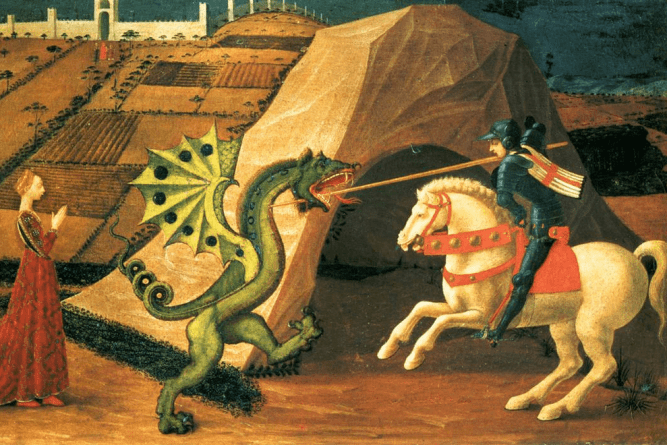
Saint George’s Day is April 23, likely the day of his martyrdom. He is often depicted as a knight in armor. He is the patron saint of England, and his day has been celebrated there since the 9th century and more recently throughout the British Commonwealth, although he was not English and never visited England.
Origin of St. George
He was born in the 3rd century in Cappadocia, modern-day Turkey, and died in Lydda, now modern-day Israel, in what would have been the ancient Roman province of Palestine, in AD 303. He would have been a Roman officer.
His story was brought back from the Holy Land to Western Europe during the Crusades during the Middle Ages, probably in the 12th century, and then popularized in the 13th century. The motif of the dragon was initially associated with the soldier saint St. Theodore Tiro (Theodore of Amasea) of northern Turkey. In the 11th century, the dragon depictions were transferred to St. George.
The Legend of St. George
The narrative of St. George and the Dragon predates the Christian era. You may be familiar with the Greek myths:
Jason and Medea, where Jason fights the sleepless (hydra) dragon — made famous by the movie Jason and the Argonauts
Perseus and Andromeda were in the movie Clash of the Titans, where Perseus faces the sea monster Cetus to rescue the princess Andromeda, although the film uses the Kraken from Norse mythology.
What is the story of St. George?
There are many versions of the narrative about St. George and the Dragon, but all contain the following similar themes:
A town is terrorized by a dragon who requires placating, eventually including human sacrifice
A young princess (Sabra?) is offered up to the dragon
St. George learns about this (from a hermit?) and rides to the town
St. George rescues the princess and slays the dragon at a vulnerable patch of skin under its arm (shades of Tolkien’s The Hobbit!)
The story goes that St. George rode into Silene (modern-day Libya) to free the city from a dragon who had a taste for humans.
Jacobus da Laragine tells in his The Golden Legend, dating back to the mid-13th century, the story that we best know, adding that St. George offered to kill the dragon if the townspeople would convert to Christianity. Fifteen thousand did, including the king.
Popularity of St. George
He became popular with English kings. Edward I (1272–1307) had banners bearing the emblem of St. George, a red cross on a white background, and Edward III (1327–77) had a strong interest in the saint and owned a relic of his blood. The St. George’s cross was not used to represent England until the reign of Henry VIII.
Pope Gelasius canonized St. George in AD 494. He is also the patron saint of Venice, Genoa, Portugal, Ethiopia, and Catalonia.
It is timely that St. George was one of the “Fourteen Holy Helpers,” a group of saints who were believed to be able to intercede during epidemics. St. George’s protection was invoked against several diseases, including the Black Death and leprosy.
In Shakespeare’s Henry V, at the Battle of Harfleur during the “Once more unto the breach, dear friends” speech, the battle cry was
“God for Harry! England, and St. George!”
The Order of the Garter (founded by Edward III in 1348) is the highest order of chivalry in the country, and King Charles III is at the helm as Sovereign of the Garter. To this day, St. George’s cross still appears on the Garter badge, and his image is the pendant of the Garter chain.
More Recent Depictions of St. George
When Martin Luther was in isolation at the Wartburg Castle in Eisenach, Germany, in 1521, he lived among knights there. Living incognito, Luther did not wear his usual monk’s habit, but instead wore a black robe with a high collar, allowing his hair and beard to grow out, thereby completing his disguise.
He carried a sword at his side, going by the name Junker Jörg or “Knight George” in honor of Eisenach’s patron saint, St. George. It was also the name of the parish school he had attended there during his youth.
When I visited the Storkyrkan, also known as the “Great Church” in Stockholm, Sweden, I saw the impressive 11-foot-tall depiction of St. George and the Dragon.
It is made of oak and has stood there for centuries. It was commissioned to commemorate the victory over Danish troops at the Battle of Brunkeberg in 1471.
Bill Petro, your friendly neighborhood historian
billpetro.com
Subscribe to have future articles delivered to your email. If you enjoyed this article, please consider leaving a comment.









